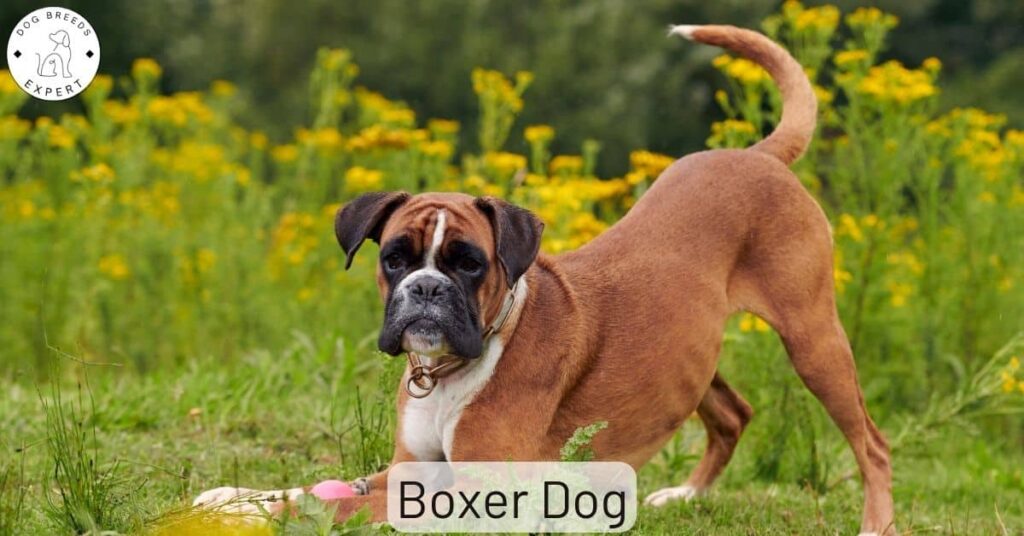The Boxer Dog is affectionate, loving, exuberant, and needs an active owner.
The Boxer dog is a high energy, athletic affectionate, fun loving clown who loves to lark around and make you laugh – no matter how old he gets!
This high-spirited whirlwind has a soft side too though. He absolutely adores his family and becomes completely devoted to them. This means that he does not like to be left alone for too long as he thrives on human contact.

Boxer dogs are great family pets as they get on with children. However, they can be a little too boisterous around very small children so they are not advised for family with very young off-spring. Also for this reason they are not advised for the elderly.
This German breed gets on with most other dogs as long as he has been socialized properly from an early age although they may try to dominate dogs of the same sex.
This adorable clown may also play a little too rough for small dogs however so care may be required here. Keep him away from small rodents such as hamsters too for this reason – a squashed hamster is not a happy hamster!
He also needs lots of room to jump around in so apartments are not recommended. They are also great escape artists so you need to make sure your backyard is secure if you want to keep a hold of your dog!
Boxer dog breeds also drool a lot, snore a lot and have a lot of gas! They can over-heat in hot weather and dislike the cold.

Breed History
Boxer dogs are of German origin and are a member of the Molosser Group. They were first introduced by crossing an Old English Bulldog with a Bullenbeisser (now extinct).
In 1895, three Germans (Friedrich Robert, Elard Konig, and R. Hopner) took it upon themselves to exhibit the Boxer in a show for the first time and the following year they founded the Deutsche Boxer Club – the world’s first Club for Boxers.
They wrote a broad standard paper which has remained largely unchanged since 1902. The breed found it’s way around Europe at the end of the 19th Century and to America by the early 20th.

Due to their stamina and loyalty, Boxer dogs were used extensively during World War II as messenger dogs, guard dogs and for attacking enemies. Thanks to their devotion and ability to form a strong bond, many Boxers returned with their soldier companions after the War and this increased their exposure and popularity even more.
In 2012 they were the 7th most popular dog in the United States.
Vital Statistics

- Height: 53 – 63cm (21 – 25 in)
- Weight: 25 – 35kgs (55 – 70lbs)
- Life Expectancy: 9 – 12 yrs
Color:
- Dark red
- Fawn
- Brindle
- All of the above with or without white markings
- White (not recognised by KC due to high proportion of deafness)
Ease Of Training
Training can be a bit of a challenge with the boxer. Although he is intelligent and picks commands up quickly, he prefers to lark about and have fun instead.
So training should be fun for him otherwise he will be stubborn and dig his heels in and refuse to co-operate.
As for exercise, how much can you give?! However much you’ve got, the Boxer dog will take it…and then some! This is one high energy dog who just cant get enough physical activity!
At least one 2 hour walk a day is the minimum recommended but this athletic, agile dog will take much more than that if you’re up for it too! Using a dog harness similar to the ones above could help you have more control over your Boxer if he likes to pull a lot on his lead.

Protection
Boxer dog breeds make excellent guard dogs as they are agile, alert and suspicious of strangers. They will bark noisily at the approach of any stranger to let you know what’s happening.
Physically, the Boxer dog is big enough to provide a visual deterrent to any would-be intruders. They are solid and muscular, and bounce around with energy and enthusiasm – enough to put most unwanted guests off!

Grooming
Boxers are easy to groom. They have a short coat which is easy to maintain and keep clean. It is recommended to pluck any excessive hairs growing in the ears which blocks them. Also, wipe out the ears after bathing or swimming.
They also drool a lot so may need daily cleaning around their mouth.
Health Considerations

- Heart defects
- A lot of gas!
- Snoring
- Cancer
- Deafness in white dogs
- Over-heating in hot weather
- Prone to bloating (you could try using an anti-gulp bowl – find the best price here !)
- Hip malformations
- Lack of thyroid hormone
- Progressive axonopathy (was a problem in the past but seems to be mostly under control now)

Fun Feeder Go Slow Anti-Gulping Dog Bowl
- Encourages eating and drinking at a slower pace
- Dishwasher safe
- Encourages pet to eat or drink at a slower pace preventing indigestion, vomiting and bloating
- Suitable for wet or dry food; Great solution for dogs who eat and drink quickly
Famous Boxer Dogs
Cash dog – owned by Benji and Joel from “Good Charlotte”



